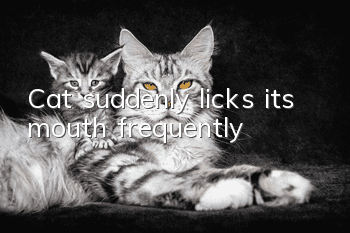Three basic factors teach you how to buy Canadian hairless cats

There are many breeds of cats, so choosing a good cat to raise requires a lot of effort in the early screening. Canadian hairless cats are born without hair, so there are certain parameters missing in breed selection, so in The choice is even more difficult to distinguish. The editor below will tell you how to choose a Canadian hairless cat based on these three basic factors:
1. Appearance characteristics
Canadian hairless cats have sparse hair, with some thin and soft lanugo hair on the ears, mouth, nose, tail fore, feet and other parts. The rest of the body is hairless. The skin is wrinkled like antelope skin and elastic. The younger the cat The rounder the face, the more wrinkles the skin has; newborn kittens have many wrinkles and are covered with fine fetal hair. As they age, the down only remains on the head, limbs, tail and body. terminal parts.
Canadian hairless cats have been bred in all cat colors, all of which appear on the skin, but with eye color that matches the body color. Pigments are present on their bodies where dark fur should appear.
The weight generally reaches 3.5 to 7 kilograms, with well-developed muscles, deep chest, hunched back, and compact but not upward abdomen. The limbs are slender, the bones are slender, and the hind limbs are longer than the forelimbs. The head is sharply angular, broad and wedge-shaped, with prominent cheekbones, thin cheeks, and a face in the shape of an equilateral triangle. The auricles are large, upright, and towering above the head. The ear tips are rounded and tilted slightly forward; the eyes are large and slightly protruding, lemon-shaped. Slightly slanted, mostly blue and golden; the upper corners of the eyes are slanted toward the ears, and the distance is wider. [2] The tail is as thin and long as a mouse, and curved and upturned like a whip.
2. Origin History
Canadian hairless cat Sphynx cat is also known as Sphynx hairless cat. As early as 1,700 years ago, there were records of indigenous people in South America and Mexico raising such hairless cats. But it wasn't until the breed became successful in cat shows that people began to take notice and become interested in it. The TlCA recognizes the breed and the cat was designated a rare breed in 2005.
The earliest recorded hairless cats were a pair of brothers born in the same litter named Nellie and Dick. In 1903, Shinnick, a native of New Mexico, purchased them from Native American Indians in Pueblo. In 1966, hairless cats were discovered again in Toronto, Canada, hence the name Canadian hairless cats. Shortly thereafter, hairless cats were also discovered in Minnesota, USA. As hairless cats become more and more famous
3. Living habits
Canadian Hairless Cats Hairless cats love to lick their bodies to clean themselves and often clean their fur. After meals, it will wipe its beard with its front paws, lick its anus with its tongue after urinating, and lick its fur with its tongue after being held. This is the little hairless cat removing odor and dirt from its body. There are many rough little protrusions on the tongue of hairless cats, which are tools for removing dirt. Hairless cats lick their coats with their tongues to stimulate the secretion of sebaceous glands and make their coats shiny and moist.It is slippery, not easily wetted by water, and can lick up a small amount of vitamin D, which promotes the normal development of bones, makes the coat fluffy, and promotes heat dissipation. Hairless cats usually start grooming and grooming their coat after eating and playing, or after vigorous pursuit of prey, or after waking up in the sun. During hot seasons or after strenuous exercise, a large amount of heat is generated in the body. In order to maintain a constant body temperature, excess heat energy must be discharged from the body. Therefore, hairless cats use their tongues to smear saliva on their coat. The evaporation of water in the saliva can take away heat and play a role in cooling down and relieving heat. Frequent combing during hair removal can promote new hair growth. In addition, by scratching and biting, you can prevent the coat from being infected with parasitic diseases, such as fleas, lice, etc., and keep your body healthy.
The behavior of hairless cats covering their feces is completely out of life instinct and is inherited from their ancestors. The ancestor of the hairless cat, the wild hairless cat, covered up its feces in order to prevent natural enemies from detecting and tracking it through the smell of its feces. This behavior of modern hairless cats no longer makes any sense in this regard, but it has given hairless cats a good reputation for hygiene.
All cats have excellent day and night vision capabilities, so Canadian hairless cats are no exception. Hairless cats still maintain the nocturnal habit of carnivores, and many activities (such as mouse hunting, courtship and mating) are often performed at night. [5] Hairless cats are most active every day at dawn or dusk, and spend most of the day lazily resting or sleeping. In bright places, hairless cats will shrink their pupils as narrow as a line to reduce damage to the retina, but this will limit the breadth of the field of vision. There is a blue-green fluorescent film (called tapetum lucidum) on the back of the omentum of hairless cats, which can increase vision in dark places. In the flash, hairless cats' eyes can appear in various colors. Like most carnivores, their eyes are pointed forward on their faces, giving them a wide field of vision. Hairless cats have poor ability to distinguish the three primary colors. If Canadian hairless cats only have dim light here, they will use their whiskers to improve mobility and perception. Beards can sense very weak winds to identify obstructions without being able to see them. Hairless cats have three eyelids. When the hairless cat's eyelids are open, the pierced eyelids will slightly cover the eyes from the side. If the hairless cat is sick, sleeping or laughing, this eyelid will retract part of it. If a hairless cat has its third eyelid exposed for a long time, it is a sign of illness.
- What are the characteristics of feline hemobartonellosis? How to treat it?
- How to treat acute renal failure in cats? How to deal with renal failure in cats!
- What should you pay attention to when raising a cat in spring? Pay attention to preventing cat plague in spring
- How to touch a cat's bladder to see if it is bloated
- Can pregnant cats take nutritional supplements?
- What should you pay attention to when raising Scottish Fold cats?
- What does it mean when a cat rolls over his belly?
- When your cat behaves in the following 5 ways towards you, it means it doesn’t like you and may even hate you.
- Cat training strategy: How to train a cat to go to the toilet?
- How big are the average cheeks of an Isle of Man tailless cat?



